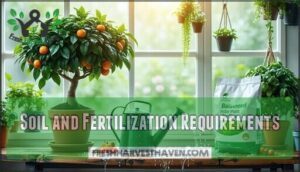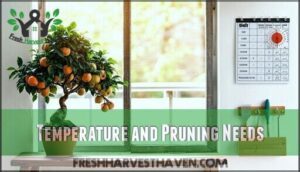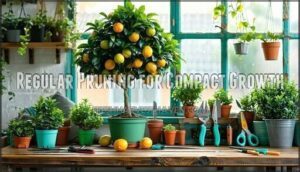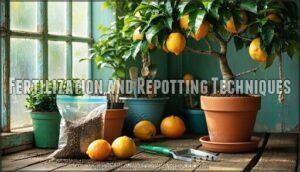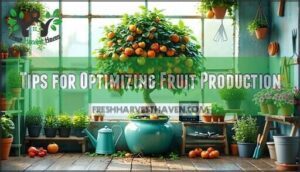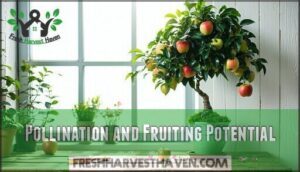This site is supported by our readers. We may earn a commission, at no cost to you, if you purchase through links.
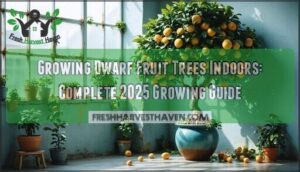
These compact powerhouses reach just 4-8 feet tall while producing full-sized fruit in containers, they’ll thrive near south-facing windows or under grow lights with well-draining potting mix and consistent moisture.
Regular pruning keeps them manageable, while proper fertilization guarantees healthy growth, hand-pollination with a small brush can boost fruit production substantially.
The secret lies in understanding their specific dormancy requirements and seasonal care adjustments that trigger abundant harvests.
Table Of Contents
- Key Takeaways
- Choosing Dwarf Fruit Trees
- Indoor Growing Conditions
- Care and Maintenance Tips
- Pollination and Fruiting Potential
- Benefits and Considerations
- Frequently Asked Questions (FAQs)
- Can dwarf fruit trees grow indoors?
- Can dwarf fruit trees stay in pots?
- Can dwarf fruit trees survive winter indoors?
- How long before trees produce their first fruit?
- What common pests attack indoor dwarf trees?
- Do dwarf trees need dormancy periods annually?
- Which varieties handle low light conditions best?
- Conclusion
Key Takeaways
- You’ll need 6-8 hours of bright light daily – Position your trees near south-facing windows or use LED grow lights 12-18 inches above the canopy to ensure proper photosynthesis and fruit development.
- Choose self-pollinating varieties for easier success – Meyer lemons, dwarf peaches, and figs don’t require cross-pollination, though you can boost yields by 40% using hand-pollination with a small paintbrush.
- Maintain 40-60% humidity and proper watering – Check soil moisture by inserting your finger two inches deep and water when dry, typically every 3-5 days, while using humidity trays to prevent stress.
- Regular pruning keeps trees productive and manageable – Prune during dormant winter months to control height at 4-8 feet, remove dead branches, and encourage bushier growth that maximizes fruit production in containers.
Choosing Dwarf Fruit Trees
Selecting the right dwarf fruit tree transforms your indoor space into a productive mini-orchard that fits your lifestyle and growing conditions.
You’ll want to match each variety’s specific light, humidity, and care requirements with what your home can realistically provide year-round, considering the complete needs of the tree.
Citrus Trees for Indoor Growing
Choosing dwarf citrus trees for indoor planting opens up a world of fresh fruit possibilities in small spaces.
Meyer lemon and Calamondin orange varieties excel in container gardening, reaching just 3-4 feet tall through strategic tree grafting onto dwarf rootstocks.
These indoor citrus champions deliver impressive fruit yield with proper citrus care and consistent lighting.
To maximize yields, understanding dwarf tree care is essential for maintaining healthy and productive trees.
Stone Fruits for Compact Spaces
Dwarf stone fruits typically thrive in 6-8 foot containers, making them perfect for compact indoor gardening.
These self-pollinating varieties require well-draining soil and consistent temperatures between 65-75°F for ideal growth.
- Bonanza Peach Care: Self-pollinating dwarf variety producing full-sized, sweet peaches in containers
- Italian Prune Plum Varieties: Compact trees yielding purple plums perfect for fresh eating and preserves
- Stella Cherry Pruning: Sweet cherry variety requiring minimal space with proper pruning techniques
- Moorpark Apricot Selection: Hardy dwarf variety producing fragrant, orange-colored fruits indoors
- Nectarcrest Nectarine Growth: Smooth-skinned stone fruit thriving in container gardening setups
Tropical Trees for Indoor Environments
While tropical dwarf fruit trees bring exotic appeal to indoor gardening, they demand specific conditions for success.
Dwarf banana varieties like Lady Finger thrive in high humidity and warm temperatures, making excellent container gardening choices.
Avocado tips include providing bright light and patience—fruiting rarely occurs indoors.
Mango varieties stay compact but need consistent warmth above 65°F for ideal growth in small space gardening environments.
For best results, consider researching dwarf fruit trees to learn more about their care and maintenance and achieve ideal growth.
Indoor Growing Conditions
Creating the right environment for your dwarf fruit trees is vital for their success indoors.
You’ll need to balance four key factors: adequate lighting, proper watering schedules, nutrient-rich soil, and consistent temperatures to guarantee healthy growth and fruit production.
Lighting Requirements for Dwarf Trees
Since most dwarf fruit trees need 6-8 hours of direct sunlight daily, you’ll want to position yours near a south-facing window for ideal natural light.
If your window placement doesn’t provide enough sunlight hours, LED grow lights become your best friend. Full-spectrum LED lights placed 12-18 inches above your tree can supplement inadequate natural lighting, ensuring healthy growth and fruiting in your indoor gardening setup.
For a successful harvest, consider the indoor growing tips to optimize your tree’s environment.
Watering and Humidity Needs
Watering your dwarf fruit trees feels like finding the sweet spot between drought and drowning.
Check soil moisture by inserting your finger two inches deep—water when it’s dry. Most trees need watering every 3-5 days, but frequency varies with humidity levels and season.
Looking at the paragraph about watering techniques and the overall tone of the content, here’s a short, engaging blockquote:
Stick your finger in the soil—it’s the best moisture meter you’ll ever own.
Use filtered water to protect root health, and maintain 40-60% humidity with trays or humidifiers for ideal growth.
Proper indoor humidifier systems help control indoor humidity levels to promote healthy tree development.
Soil and Fertilization Requirements
Well-draining soil serves as your dwarf fruit trees’ foundation for healthy growth.
Choose a quality potting mix with perlite or coarse sand to prevent waterlogged roots. Most dwarf fruit trees thrive in slightly acidic soil with pH levels between 6.0-7.0.
Feed your trees with balanced indoor plant fertilizers during growing season, adjusting nutrient levels based on soil requirements and specific tree needs.
When selecting a potting mix, consider the importance of proper soil mix components for ideal tree health, and ensure to choose a mix that supports the overall growth of your dwarf fruit trees.
Temperature and Pruning Needs
Success in indoor tree growing depends on maintaining ideal temperature ranges and strategic pruning schedules.
Most dwarf fruit trees thrive between 65-75°F, though winter care requires cooler periods for dormancy.
Regular pruning with sterilized tools controls size and prevents heat stress.
Fruit thinning improves quality while temperature control prevents branch damage.
Winter pruning promotes spring growth in your indoor plant care routine.
Care and Maintenance Tips
Proper care guarantees your dwarf fruit trees thrive indoors and produce healthy harvests year after year.
You’ll need to master three key maintenance areas: pruning for size control, fertilization timing, and repotting techniques that support ideal growth.
Regular Pruning for Compact Growth
Regular pruning keeps your dwarf fruit trees manageable and productive.
Sharp pruning tools help you shape compact growth by removing dead branches and controlling height.
Follow pruning schedules during dormant winter months for best results.
Dwarf citrus trees respond well to light trimming that maintains their natural form.
Proper dwarf maintenance through strategic cuts encourages bushier, more fruitful indoor tree growing patterns.
Fertilization and Repotting Techniques
Proper fertilization and repotting keep your dwarf fruit trees thriving year after year.
These container fruit trees need specialized care to maintain healthy growth in limited soil space. Using the right fruit tree fertilizers is essential for their development.
- Soil Mix: Use well-draining potting mix with perlite and compost for ideal root health
- Fertilizer Types: Apply citrus-specific blends during growing season for balanced nutrition
- Repotting Methods: Move to slightly larger containers when roots circle the pot
- Root Pruning: Trim circled roots gently before repotting to encourage new growth
- Nutrient Cycling: Replace top soil layer annually to refresh depleted nutrients
Tips for Optimizing Fruit Production
Beyond standard watering schedules, strategic cluster thinning boosts remaining fruit size by 35% while improving sugar content.
You’ll maximize fruit yield through precise temperature control during flowering phases—maintaining 65-75°F enhances pollen viability substantially.
Quality soil amendments and weekly pest control inspections prevent 80% of production issues.
Proper harvest timing ensures peak flavor development in your container fruit trees. Understanding soil quality factors is vital for optimizing the growth of dwarf fruit trees indoors, which benefits from precise temperature control.
Pollination and Fruiting Potential
Understanding pollination is essential for indoor fruit production success with your dwarf trees.
You’ll need to master hand-pollination techniques since natural pollinators aren’t available indoors, and knowing which varieties are self-pollinating versus those requiring cross-pollination will determine your harvest potential, which involves understanding the importance of cross-pollination.
Self-Pollinating Dwarf Fruit Trees
Many dwarf fruit trees are selfpollinating, meaning they don’t need another tree for pollen transfer.
Dwarf citrus varieties like Meyer lemons and most fig trees produce fruit independently through self fruiting mechanisms.
These compact fruit trees rely on tree grafting techniques that preserve their natural pollination abilities.
Indoor dwarf trees still benefit from gentle shaking to encourage pollen movement, boosting fruit yield naturally.
Understanding proper pollen transfer methods is essential for maximizing fruit production in these trees, using techniques like gentle shaking to improve pollen movement.
Hand-Pollination Techniques for Increased Yield
While self-pollinating dwarf fruit trees can produce fruit independently, hand pollination boosts your harvest substantially.
You’ll become the matchmaker for your indoor orchard, controlling pollen transfer for maximum fruit yield.
Here are five proven hand pollination methods for dwarf fruit trees:
- Soft-bristled paintbrush technique – Gently brush male flowers, then transfer pollen to female stigmas on citrus and stone fruits
- Cotton swab application – Use clean swabs for precise pollen placement on delicate flower structures
- Branch shaking method – Vibrate self-pollinating varieties like dwarf peaches to release pollen naturally
- Direct stamen contact – Touch male stamens directly to female stigmas for immediate pollen transfer
- Cross pollination between cultivars – Transfer pollen between different varieties for enhanced fruit set
Time your pollination efforts for mid-morning when flowers are fully open and pollen is most viable.
Repeat daily for three to five days during peak blooming periods.
Factors Affecting Fruit Production Indoors
Several factors directly impact your dwarf fruit trees’ ability to produce fruit indoors.
Indoor climate control affects flowering cycles, while soil quality determines nutrient uptake for fruit development.
Tree genetics play a major role – some indoor fruit tree varieties naturally produce better fruit yield than standard types.
Light spectrum influences photosynthesis and fruiting hormones, and temperature fluctuations stress trees, reducing fruit production by up to 50%.
Proper indoor plant care tips address these variables for growing fruit indoors successfully.
Strategies for Improving Pollination Success
You can boost fruit set by 40% through strategic hand pollination techniques.
Use a small, clean paintbrush to transfer pollen between flowers during morning hours when pollen is most viable.
For cross pollination varieties, collect pollen from multiple trees if available.
Gently shake branches to simulate wind movement, enhancing natural pollen transfer for better indoor fruit cultivation success.
Benefits and Considerations
Growing dwarf fruit trees indoors offers several compelling advantages that make them an attractive option for home gardeners.
You’ll gain complete control over growing conditions while enjoying fresh, homegrown fruit without needing a large outdoor space, which is a significant advantage of homegrown fruit.
Advantages of Growing Dwarf Fruit Trees Indoors
Cultivating dwarf fruit trees indoors transforms your home into a productive urban farming haven.
These compact gardening champions deliver multiple benefits that make indoor gardening tips worth following.
- Enhanced Indoor Air Quality – Trees naturally filter pollutants while producing oxygen
- Year-Round Fresh Produce – Harvest homegrown fruit regardless of weather conditions
- Low Maintenance Requirements – Growing trees indoors eliminates pest control and weather protection
- Space-Efficient Design – Indoor dwarf trees maximize productivity in minimal square footage
Space and Lighting Considerations
Window Placement matters most for indoor fruit trees—south-facing windows deliver ideal Light Intensity for 6-8 hours daily.
Consider Room Layout when positioning compact gardening setups, utilizing Corner Spaces and adjusting Shelf Height for maximum sun exposure.
Without adequate natural light, grow lights become essential. Your small fruit trees need strategic indoor plant lighting placement to thrive and produce fruit consistently, relying on south-facing windows and proper Room Layout.
Potential Challenges and Solutions
Most indoor fruit trees face predictable challenges that you can tackle with the right approach.
Spider mites and aphids target stressed dwarf varieties, while poor soil quality leads to nutrient deficiency and stunted growth.
- Pest Control: Use neem oil sprays and inspect leaf joints weekly for early detection
- Root Bound: Repot when roots circle the container to prevent nutrient uptake issues
- Leaf Drop: Maintain stable temperatures and avoid overwatering to prevent stress responses
- Plant Diseases: Guarantee proper drainage and air circulation to combat fungal infections
Long-Term Care and Maintenance Requirements
Commitment to long-term success means mastering Tree Pruning annually, managing Soil Management through regular repotting, and maintaining Water Balance consistency.
Your indoor plant maintenance routine should include monthly Pest Control inspections and Root Care assessments.
Dwarf tree care requires patience—fruit tree cultivation rewards dedication with years of harvests through proper indoor plant watering and indoor plant pruning schedules, demonstrating the importance of long-term success.
Frequently Asked Questions (FAQs)
Can dwarf fruit trees grow indoors?
Picture vibrant citrus blossoms filling your living room with Mediterranean charm.
Yes, you can successfully grow dwarf fruit trees indoors.
These compact varieties thrive in containers, producing real fruit when given proper sunlight and care.
Can dwarf fruit trees stay in pots?
Yes, dwarf fruit trees thrive permanently in pots.
They’re specifically grafted to stay compact with shallow root systems.
You’ll need well-draining containers and proper care, but they’ll produce fruit for years without transplanting to ground, which is a significant advantage of having compact trees.
Can dwarf fruit trees survive winter indoors?
You’ll successfully overwinter dwarf fruit trees indoors by providing adequate light, maintaining proper temperatures, and adjusting watering schedules. Most varieties thrive in heated homes with consistent care.
How long before trees produce their first fruit?
Most dwarf fruit trees bear their first fruit within 2-3 years, much faster than standard trees which take 5-7 years.
You’ll enjoy homegrown citrus, figs, and stone fruits sooner than expected.
What common pests attack indoor dwarf trees?
You’ll spot aphids, scale insects, spider mites, and mealybugs attacking your trees most frequently. These tiny sap-suckers thrive in warm, dry indoor conditions and multiply rapidly without natural predators.
Do dwarf trees need dormancy periods annually?
Like winter’s embrace awakening spring growth, most dwarf trees don’t require dormancy periods indoors.
You’ll maintain consistent temperatures year-round.
However, olive trees need cool periods for ideal fruiting—around 45-50°F for several weeks annually, which can be considered a dormancy period.
Which varieties handle low light conditions best?
Fig trees and citrus varieties like Meyer lemons tolerate lower light better than most dwarf fruits.
You’ll still need bright indirect light, but they’re more forgiving than stone fruits which demand full sun daily.
Conclusion
Successful growing dwarf fruit trees indoors isn’t just wishful thinking—it’s achievable with proper technique.
You’ll need consistent light, appropriate humidity, and patience for your trees to establish fruiting cycles.
Your dedication to proper care, including seasonal adjustments and dormancy periods, directly impacts harvest quality.
With self-pollinating varieties and hand-pollination techniques, you can enjoy homegrown fruit year-round.
Growing dwarf fruit trees indoors transforms any space into a productive miniature orchard.
- https://theultimatehomestead.com/dwarf-fruit-trees-you-can-grow-indoors/
- https://extension.umn.edu/houseplants/growing-citrus-indoors
- https://nationwideplants.com/collections/indoor-fruit-trees-plants
- https://extension.umd.edu/resource/growing-dwarf-citrus
- https://www.xroci.com/blogs/xroci-guide-and-tips/tiny-trees-big-flavor-discover-how-to-care-for-dwarf-fruit-trees-indoors



